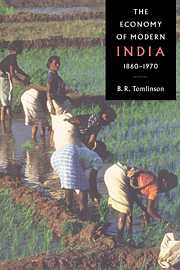Book contents
- Frontmatter
- 1 Introduction: development and underdevelopment in colonial India
- 2 Agriculture 1860–1950: land, labour and capital
- 3 Trade and manufacture, 1860–1945: firms, markets and the colonial state
- 4 The state and the economy, 1939–1970: the emergence of economic management in India
- 5 Conclusion
- Bibliographical essay
- Index
- THE NEW CAMBRIDGE HISTORY OF INDIA
- Map I.I India in 1937-8
- References
2 - Agriculture 1860–1950: land, labour and capital
Published online by Cambridge University Press: 28 March 2008
- Frontmatter
- 1 Introduction: development and underdevelopment in colonial India
- 2 Agriculture 1860–1950: land, labour and capital
- 3 Trade and manufacture, 1860–1945: firms, markets and the colonial state
- 4 The state and the economy, 1939–1970: the emergence of economic management in India
- 5 Conclusion
- Bibliographical essay
- Index
- THE NEW CAMBRIDGE HISTORY OF INDIA
- Map I.I India in 1937-8
- References
Summary
Inadequate agricultural production lay at the heart of India’s development problems in the late nineteenth and early twentieth centuries. The rural sector, comprising agriculture, and ancillary activities such as animal husbandry, forestry and fishing, was the foundation of the colonial economy. It employed about three-quarters of the workforce and produced well over half of national income between the 1860s and the 1940s. However, there were also severe productivity constraints, linked to problems of labour utilisation, as well as an endemic scarcity of capital and a lack of investment in irrigation and other capital inputs, creating in turn a shortage of productive land.
Although several regions experienced some growth in agricultural output during the last quarter of the nineteenth century, a steady rate of population increase from the 1920s onwards resulted in an emerging subsistence crisis by the middle of the twentieth century, caused by both poor availability of food and skewed entitlements. In addition, low wages and other returns to labour in the rural economy limited demand for basic wage goods such as food and textiles, which in turn weakened the launching pad for take-off to wide-reaching economic growth based on mass consumption in the domestic market. One recent general estimate suggests that while the proportion of the workforce employed in agriculture increased very slightly between 1911 and 1951, the percentage of national income derived from the agricultural sector fell by 9 per cent over the same period, suggesting an equivalent fall in the relative product per worker in agriculture.
Keywords
- Type
- Chapter
- Information
- The Economy of Modern India, 1860–1970 , pp. 30 - 91Publisher: Cambridge University PressPrint publication year: 1993

